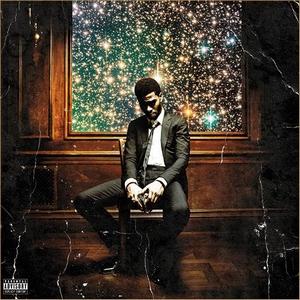The birth of hip hop was powered by a strong desire for change, giving artists whom previously would be ignored a platform to display their opinions. Modern day hip hop, when compared to the classic rebellious anthems of hip hop groups such as “Public Enemy” and “A Tribe Called Quest”, is truly unrecognizable. For those who are frustrated with the modern club music heard on the radio, which consists of meaningless lyrics containing no message, Cleveland’s own Kid Cudi has arrived as a true throwback to the roots of hip hop.
In September of 2009, Cudi released his debut album entitled “Man On The Moon: The End Of The Day”. Lead by hit single “Day ‘N’ Nite”, “The End Of The Day” spread throughout the nation like wildfire, becoming an instant success. With his debut, Cudi proved to listeners that he had more important issues to speak of than “applebottom jeans with the boots with the fur”, as he welcomed listeners into his world of drug abuse and his fun-loving lifestyle. Cudi’s honesty and forwardness helps listeners to connect with him at a more personal level.
On November 9, 2010, Kid Cudi released his sophomore effort entitled “The Man On The Moon II: The Legend Of Mr. Rager”. This album proved to follow Cudi’s one and only musical trend, and is entirely different than anything else in the hip hop world at this time. “The End Of The Day” shows life in a blissful light, with anthems promoting individualism such as “Pursuit of Happiness” and “Heart Of A Lion”. Cudi let it be known to fans that the second album in the “Man On The Moon” series would show the life of Cudi in a much darker perspective, but few could have predicted the intense pessimistic mood of “The Legend Of Mr. Rager”.
From start to finish, it is obvious to listeners that the goal of this album is to introduce Cudi fans to the dark side of the life of Scott Mescudi, the man behind the Kid Cudi stage name. “Dont’ Play This Song”, a collaboration with hip hop legend Mary J. Blige, drags listeners into the deep drug addictions that have plagued Cudi for years. Elaborating on this point two tracks later is “Marijuana”, an overly repetitive attempt at a stoner anthem that comes up short of previous Cudi hits such as “Cudi Zone”. Similarly “Ashin’ Kusher” also encourages the use of marijuana but in a less repetitive manner, featuring a shorter chorus and more intricate verses. Cudi also opens his past addiction to cocaine up to listeners for the first time, bringing the relationship between Cudi and his listeners even closer. One could become increasingly irritated by the constant drug references in “The Legend Of Mr. Rager”, but at the same time what else could one expect from a man who is often compared to a modern day Bob Marley?
Another previously taboo subject that “The Legend Of Mr. Rager” centers around is the deep depression which fame has brought upon Cudi. “The End”, a collaboration with GLC, Chip Tha Ripper, and Nicole Wray, intimately examines the burden placed on successful hip hop artists who rap with a message, and how to successfully cope with these issues. Another track surrounding Cudi’s depression is “Maniac”, which explores Cudi’s life of solitude. With lyrics such as “I’m in the shadows in the corner of my room / This is my new hideaway / This is my tomb”, “Maniac” smoothly transitions to songs such as “Trapped In My Mind” and “These Worries”, which features a heavy chorus from Mary J. Blige. “Ghost” is a five minute anthem which examines Cudi’s depression after a break up. In this heart wrenching track, Cudi asks himself, “When did I become a ghost?” The shocking vulnerability of Cudi that is exhibited in these dark tracks helps listeners to learn the troubles that “Kid Cudi” has brought upon Scott Mescudi.
Signs of the old fun loving Cudi are rare but nonetheless present on “The Legend Of Mr. Rager”. “Revofev”, standing for “Revolution of Evolution”, is a three minute plea to listeners to participate in a revolution of individualism. “Revofev” often contradicts the messages of other tracks on “The Legend Of Mr. Rager” as Cudi tells his listeners that stress is unnecessary and will only bring one’s spirits down. When listening, one can not help but wish that Cudi would take his own advice and eliminate monotonous tracks that seem to dwell on his personal issues of paranoia and depression.
The care free lyrics which helped to make “The End Of The Day” an immense success are shown in “Wild’n Cuz I’m Young” and “Mr. Rager” which defend Cudi’s hard partying ways. “Day ‘N’ Nite’ was essential in the success of “The End Of The Day”. “The Legend Of Mr. Rager” possesses a far more superior single in Cudi’s collaboration with Kanye West entitled “Erase Me”, which once again examines a failed relationship but instead in a more positive light. “The Legend of Mr. Rager’s” positive tracks provide hope to listeners that an album similar to “The End Of The Day” could be released in the foreseeable future.
To compare “The Legend Of Mr. Rager” to “The End Of The Day” would not do justice to this album. Cudi uses “The Legend of Mr. Rager” to deliver the message that is his life. While dark and depressing at times, one can not help but be inspired by the new style exhibited by Cudi. Through his masterful lyrics and incomparable beats, Kid Cudi sets himself apart from the world of modern day hip hop. “The Legend Of Mr. Rager” thoroughly proves that Kid Cudi is one of those artists who surface very rarely with a style so different that they could indeed be classified as their own genre.









